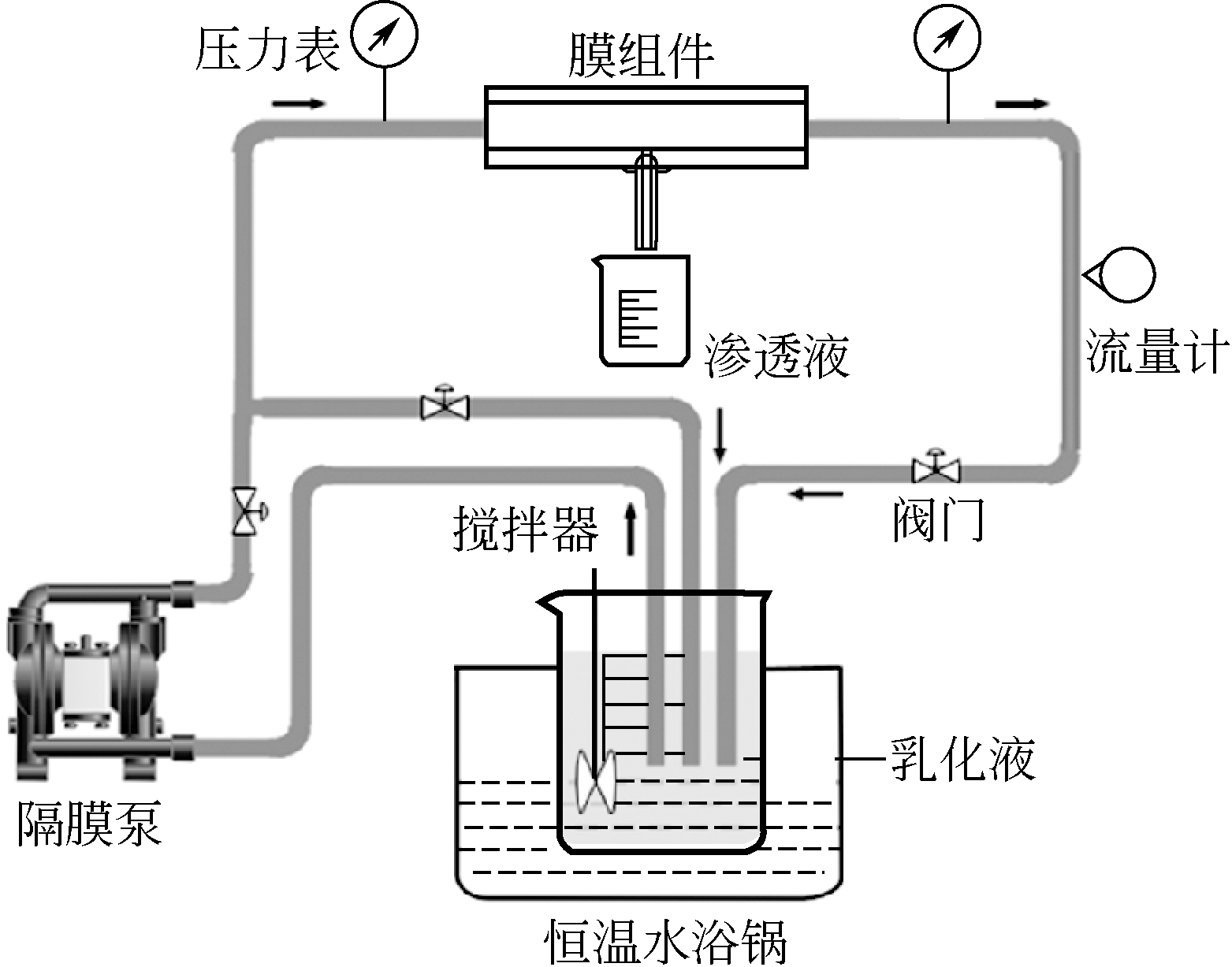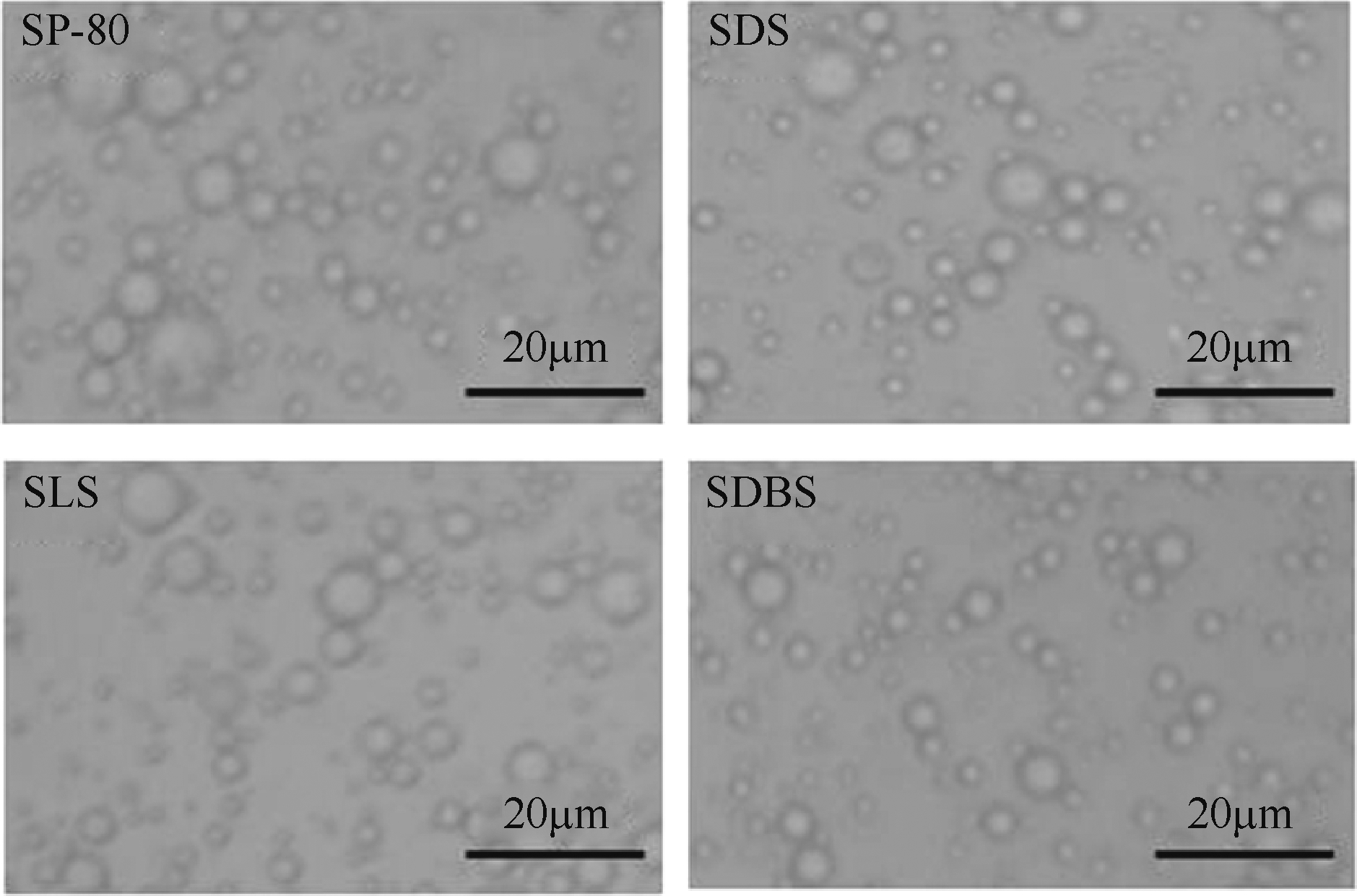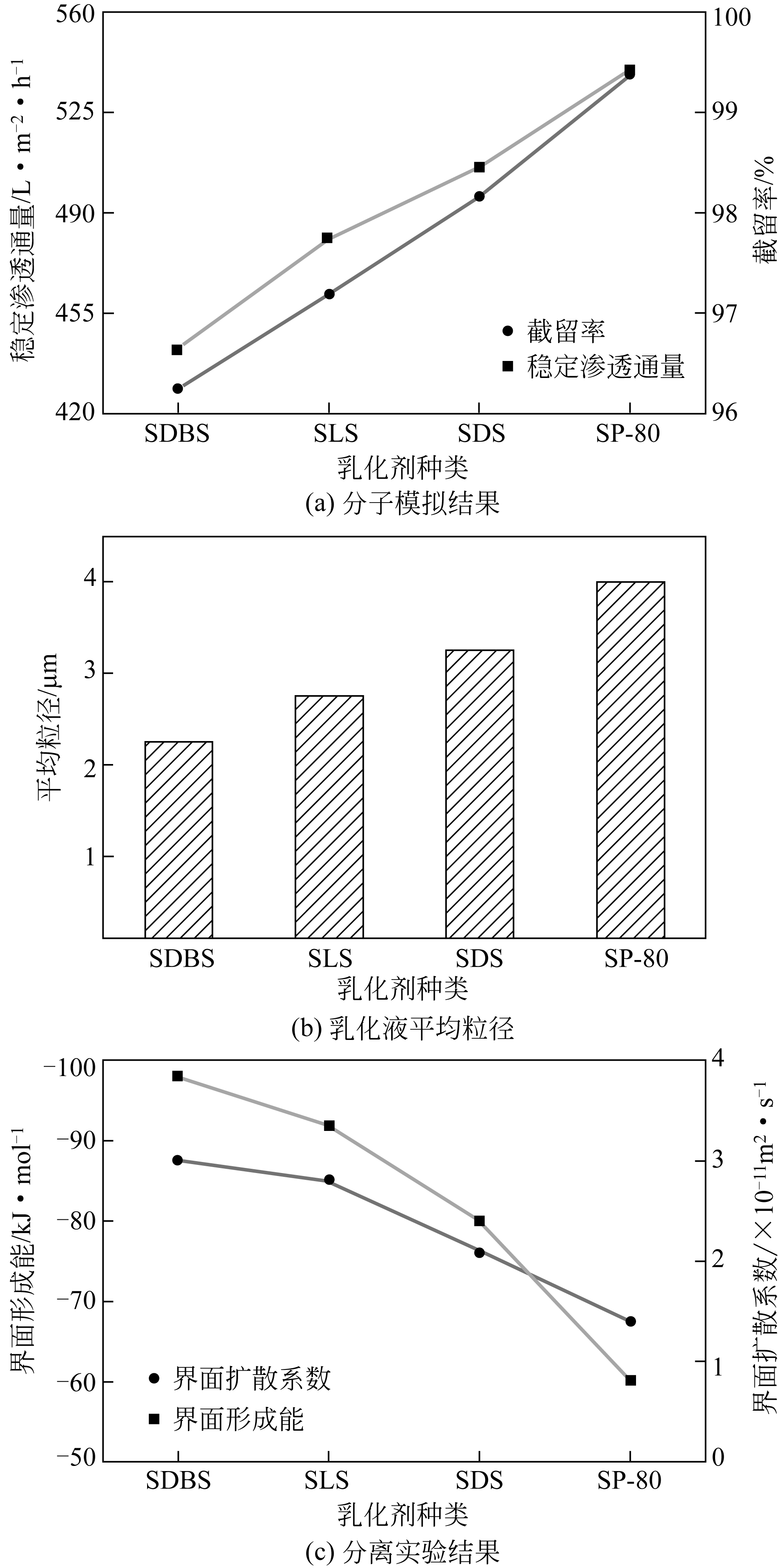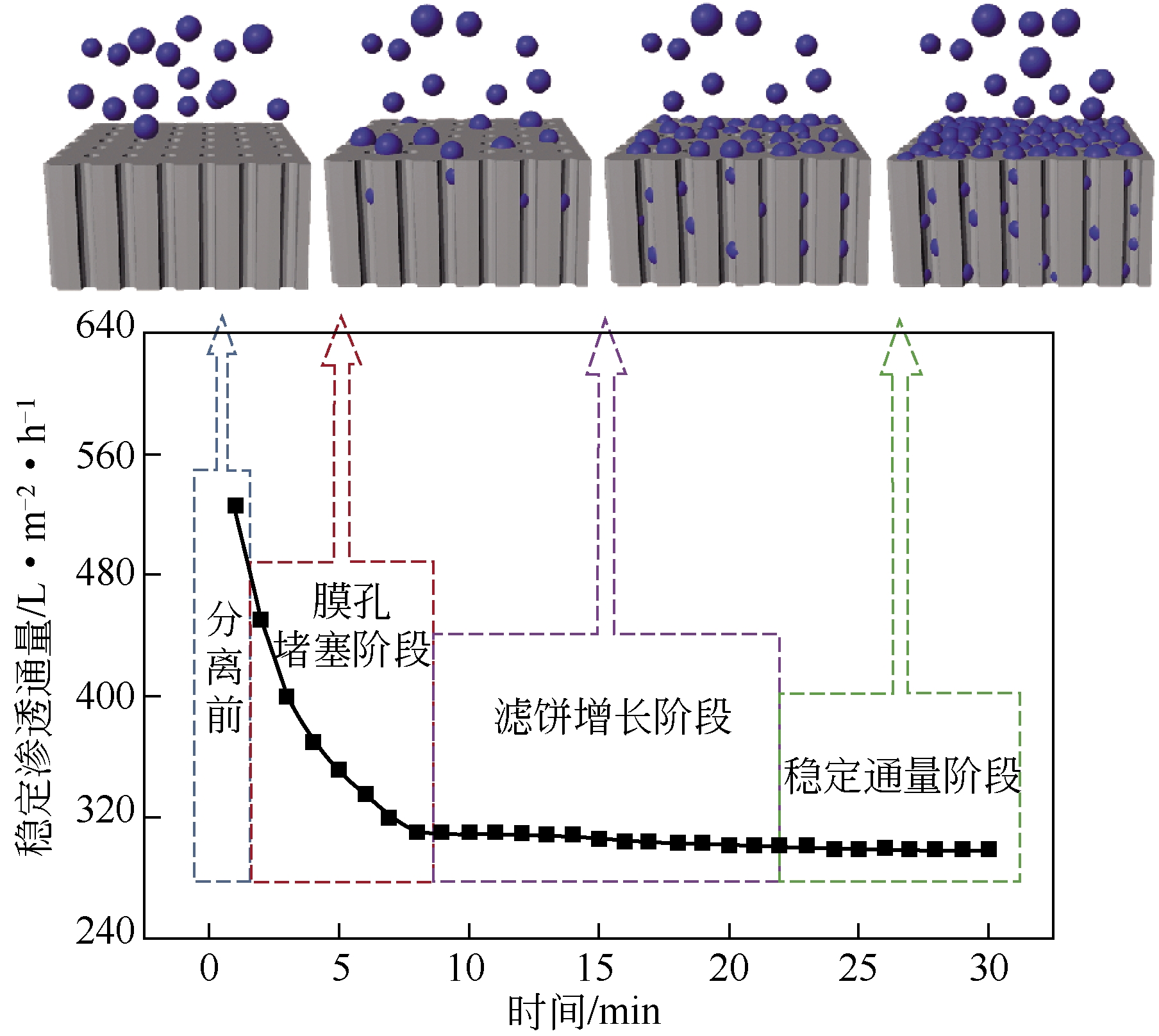Chemical Industry and Engineering Progress ›› 2019, Vol. 38 ›› Issue (02): 790-797.DOI: 10.16085/j.issn.1000-6613.2018-0766
• Chemical processes and equipment • Previous Articles Next Articles
Impact of emulsifier on separation of oil-in-water emulsion by dynamic membrane
Xuefang ZHANG( ),Yanqiu PAN(
),Yanqiu PAN( ),Pengpeng CHEN,Lu YU
),Pengpeng CHEN,Lu YU
- School of Chemical Engineering, Dalian University of Technology, Dalian 116024, Liaoning, China
-
Received:2018-04-13Revised:2018-06-29Online:2019-02-05Published:2019-02-05 -
Contact:Yanqiu PAN
乳化剂对动态膜分离油水乳化液过程的影响
- 大连理工大学化工学院,辽宁 大连 116024
-
通讯作者:潘艳秋 -
作者简介:<named-content content-type="corresp-name">张雪芳</named-content>(1992—),女,硕士研究生,研究方向为油水分离技术。E-mail:<email>zhangxf@mail.dlut.edu.cn</email>。|潘艳秋,教授,工学博士,博士生导师,研究方向为化工分离过程。E-mail:<email>yqpan@dlut.edu.cn</email>。
CLC Number:
Cite this article
Xuefang ZHANG, Yanqiu PAN, Pengpeng CHEN, Lu YU. Impact of emulsifier on separation of oil-in-water emulsion by dynamic membrane[J]. Chemical Industry and Engineering Progress, 2019, 38(02): 790-797.
张雪芳, 潘艳秋, 陈鹏鹏, 俞路. 乳化剂对动态膜分离油水乳化液过程的影响[J]. 化工进展, 2019, 38(02): 790-797.
share this article
Add to citation manager EndNote|Ris|BibTeX
URL: https://hgjz.cip.com.cn/EN/10.16085/j.issn.1000-6613.2018-0766
| 元素分析 | 核磁基础数据 | 平均结构单元参数 | |||
|---|---|---|---|---|---|
| 元素 | 分率 | 类型 | 分率 | 类型 | 分率 |
| 碳元素 | 0.839 | 芳环氢 | 0.040 | 芳香碳率 | 0.168 |
| 氢元素 | 0.124 | α位取代氢 | 0.082 | 环烷碳率 | 0.200 |
| 氮元素 | 0.023 | β位取代氢 | 0.602 | 烷基碳率 | 0.632 |
| 杂元素 | 0.014 | γ位取代氢 | 0.276 | 烷链支化度 | 0.322 |
| 芳香环系缩合度参数 | 0.440 | ||||
| 氢碳元素比(H/C) | 1.770 | 平均相对分子质量 | 537 | 芳香环系周边氢取代率 | 0.603 |
| 元素分析 | 核磁基础数据 | 平均结构单元参数 | |||
|---|---|---|---|---|---|
| 元素 | 分率 | 类型 | 分率 | 类型 | 分率 |
| 碳元素 | 0.839 | 芳环氢 | 0.040 | 芳香碳率 | 0.168 |
| 氢元素 | 0.124 | α位取代氢 | 0.082 | 环烷碳率 | 0.200 |
| 氮元素 | 0.023 | β位取代氢 | 0.602 | 烷基碳率 | 0.632 |
| 杂元素 | 0.014 | γ位取代氢 | 0.276 | 烷链支化度 | 0.322 |
| 芳香环系缩合度参数 | 0.440 | ||||
| 氢碳元素比(H/C) | 1.770 | 平均相对分子质量 | 537 | 芳香环系周边氢取代率 | 0.603 |
| 实验号 | 因素 | 评价指标 | |||||
|---|---|---|---|---|---|---|---|
| 乳化剂种类 | 浓度 /g?L-1 | 操作压力/MPa | 流量 / L?h-1 | 温度 /℃ | 稳定渗透通量 / L?m-2 ?h-1 | 油截留率 /% | |
| 1 | SDS | 0.25 | 0.08 | 60 | 20 | 42.25 | 98.35 |
| 2 | SDS | 0.5 | 0.10 | 80 | 30 | 68.29 | 98.02 |
| 3 | SDS | 0.75 | 0.12 | 100 | 40 | 156.47 | 97.88 |
| 4 | SDS | 1.00 | 0.14 | 120 | 50 | 480.97 | 97.12 |
| 5 | SDBS | 0.25 | 0.14 | 80 | 40 | 341.56 | 97.75 |
| 6 | SDBS | 0.50 | 0.12 | 60 | 50 | 305.24 | 97.34 |
| 7 | SDBS | 0.75 | 0.10 | 120 | 20 | 203.59 | 98.56 |
| 8 | SDBS | 1.00 | 0.08 | 100 | 30 | 151.86 | 98.25 |
| 9 | SLS | 0.25 | 0.10 | 100 | 50 | 273.65 | 97.25 |
| 10 | SLS | 0.50 | 0.08 | 60 | 40 | 92.18 | 98.11 |
| 11 | SLS | 0.75 | 0.14 | 120 | 30 | 352.14 | 97.55 |
| 12 | SLS | 1.00 | 0.12 | 80 | 20 | 125.36 | 96.05 |
| 13 | SP-80 | 0.25 | 0.12 | 120 | 30 | 240.32 | 99.01 |
| 14 | SP-80 | 0.50 | 0.14 | 100 | 20 | 201.36 | 99.25 |
| 15 | SP-80 | 0.75 | 0.08 | 80 | 50 | 112.96 | 98.76 |
| 16 | SP-80 | 1.00 | 0.10 | 60 | 40 | 79.88 | 98.56 |
| 实验号 | 因素 | 评价指标 | |||||
|---|---|---|---|---|---|---|---|
| 乳化剂种类 | 浓度 /g?L-1 | 操作压力/MPa | 流量 / L?h-1 | 温度 /℃ | 稳定渗透通量 / L?m-2 ?h-1 | 油截留率 /% | |
| 1 | SDS | 0.25 | 0.08 | 60 | 20 | 42.25 | 98.35 |
| 2 | SDS | 0.5 | 0.10 | 80 | 30 | 68.29 | 98.02 |
| 3 | SDS | 0.75 | 0.12 | 100 | 40 | 156.47 | 97.88 |
| 4 | SDS | 1.00 | 0.14 | 120 | 50 | 480.97 | 97.12 |
| 5 | SDBS | 0.25 | 0.14 | 80 | 40 | 341.56 | 97.75 |
| 6 | SDBS | 0.50 | 0.12 | 60 | 50 | 305.24 | 97.34 |
| 7 | SDBS | 0.75 | 0.10 | 120 | 20 | 203.59 | 98.56 |
| 8 | SDBS | 1.00 | 0.08 | 100 | 30 | 151.86 | 98.25 |
| 9 | SLS | 0.25 | 0.10 | 100 | 50 | 273.65 | 97.25 |
| 10 | SLS | 0.50 | 0.08 | 60 | 40 | 92.18 | 98.11 |
| 11 | SLS | 0.75 | 0.14 | 120 | 30 | 352.14 | 97.55 |
| 12 | SLS | 1.00 | 0.12 | 80 | 20 | 125.36 | 96.05 |
| 13 | SP-80 | 0.25 | 0.12 | 120 | 30 | 240.32 | 99.01 |
| 14 | SP-80 | 0.50 | 0.14 | 100 | 20 | 201.36 | 99.25 |
| 15 | SP-80 | 0.75 | 0.08 | 80 | 50 | 112.96 | 98.76 |
| 16 | SP-80 | 1.00 | 0.10 | 60 | 40 | 79.88 | 98.56 |
| A | —— | 膜表面积,m2 |
| c f | —— | 进料液中油浓度, mg/L |
| c p | —— | 渗透液中油浓度, mg/L |
| D m | —— | 膜管内径, m |
| E t ,E s ,E ow | —— | 分别为油水乳化剂体系的总能量、乳化剂单分子能量、单独油水体系的能量, kJ/mol |
| J | —— | 渗透通量, L/(m2?h) |
| L | —— | 膜管有效长度, m |
| m | —— | 渗透液质量, g |
| n | —— | 乳化剂分子个数 |
| R | —— | 油截留率, % |
| t | —— | 取渗透液的操作时间, h |
| V | —— | 渗透液体积, L |
| ρ | —— | 混合液密度(近似取水的密度), g/L |
| A | —— | 膜表面积,m2 |
| c f | —— | 进料液中油浓度, mg/L |
| c p | —— | 渗透液中油浓度, mg/L |
| D m | —— | 膜管内径, m |
| E t ,E s ,E ow | —— | 分别为油水乳化剂体系的总能量、乳化剂单分子能量、单独油水体系的能量, kJ/mol |
| J | —— | 渗透通量, L/(m2?h) |
| L | —— | 膜管有效长度, m |
| m | —— | 渗透液质量, g |
| n | —— | 乳化剂分子个数 |
| R | —— | 油截留率, % |
| t | —— | 取渗透液的操作时间, h |
| V | —— | 渗透液体积, L |
| ρ | —— | 混合液密度(近似取水的密度), g/L |
| 1 | 张文林, 李春利, 侯凯湖 . 含油废水处理技术研究进展[J]. 化工进展, 2005, 24(11): 1239-1243. |
| ZHANG Wenlin , LI Chunli , HOU Kaihu . Progress of oil-bearing wastewater treatment processes[J]. Chemical Industry and Engineering Progress, 2005, 24(11): 1239-1243. | |
| 2 | TONG K , ZHANG Y , LIU G , et al . Treatment of heavy oil wastewater by a conventional activated sludge process coupled with an immobilized biological filter[J]. International Biodeterioration & Biodegra Dation, 2013, 84(5):65-71. |
| 3 | BERN F . Physical-chemical methods of treatment for oil-containing effluents[J]. Waterence & Technology, 2011, 14(4):1195-1207. |
| 4 | 孙琳, 田园媛, 蒲万芬, 等 . 高温低渗油藏表面活性剂驱影响因素研究[J]. 油田化学, 2013, 5(2): 216-220. |
| SUN Lin , TIAN Yuanyuan , PU Wanfen , et al . Study on the influence factors of surfactant flouding in high-temperature low-permeability reservoir[J]. Oil Chemistry, 2013, 5(2):216-220. | |
| 5 | 陈银平 . 陶瓷膜基动态膜的制备及在油水分离中的应用[D]. 大连: 大连理工大学, 2013. |
| CHEN Yinping . The application of dynamic membrane formed on ceramic tube in the separation of oil-in-water emulsions[D]. Dalian: Dalian University of Technology, 2013. | |
| 6 | VINCENT-VELA M C , CUARTAS-URIBE B , ALVAREZ-BLANCO S , et al . Analysis of fouling resistances under dynamic membrane filtration[J]. Chemical Engineering and Processing, 2011, 50(4): 404-408. |
| 7 | ZHAO Y J , TAN Y , WONG F S , et al . Formation of dynamic membranes for oily water separation by crossflow filtration[J]. Separation and Purification Technology, 2005, 44(3): 212-220. |
| 8 | 孙宏梅, 潘艳秋, 柏斌, 等 . 炭膜基亲水性无机动态膜的制备研究[J]. 高校化学工程学报, 2011, 25(6): 1062-1067. |
| SUN Hongmei , PAN Yanqiu , BO Bin , et al . The study of preparation of hydrophilic inorganic dynamic membranes based on tubular porous carbon membrane[J]. Journal of Chemical Engineering of Chinese Universities, 2011, 25(6): 1062-1067. | |
| 9 | 王文娟, 赵昊瀚, 潘艳秋 . 动态膜分离油水乳化液操作条件优化和影响因素分析[J]. 高校化学工程学报,2015,29(5):1045-1052. |
| WANG Wenjuan , ZHAO Haohan , PAN Yanqiu . Process optimization and characterization of oil-in-water emulsion separation with dynamic membranes[J]. Journal of Chemical Engineering of Chinese Universities, 2015, 29(5): 1045-1052. | |
| 10 | DONG Z , LIN M , HAO W , et al . Influence of surfactants used in surfactant-polymer flooding on the stability of Gudong crude oil emulsion[J]. Petroleum Science, 2010, 7(2): 263-267. |
| 11 | 马宝东 . 表面活性剂提高油田污水回注效率的机理研究[D]. 济南: 山东大学, 2014. |
| Baodong MA . Mechanism of surfactant improving oilfield wastewater recycling efficiency[D]. Jinan: Shandong University, 2014. | |
| 12 | 殷红军 . 大庆油田含油污水处理关键技术参数研究[D]. 长春: 吉林大学, 2016. |
| YIN Hongjun . Research on key technical parameters of oily wastewater treatment in Daqing Oilfield[D]. Changchun: Jinlin University, 2016. | |
| 13 | FERNÁNDEZ EVA , JOSÉ MANUEL BENITO, PAZOS CARMEN , et al . Ceramic membrane ultrafiltration of anionic and nonionic surfactant solutions[J]. Journal of Membrane Science, 2005, 246(1): 1-6. |
| 14 | CHIU T Y , JAMES A E . Microfiltration of amphoteric surfactant using ceramic membranes[J]. Colloids and Surfaces A, 2006, 280: 58-65. |
| 15 | MATOS M , GUTIÉRREZ G , LOBO A , et al . Surfactant effect on the ultrafiltration of oil-in-water emulsions using ceramic membranes[J]. Journal of Membrane Science, 2016, 520: 749-759. |
| 16 | 王文娟 . 油水分离动态膜制备、应用及其形成机理研究[D]. 大连: 大连理工大学, 2015. |
| WANG Wenjuan . The research for dynamic membrane preparation, application of oily wastewater separation and its formation mechanism [D]. Dalian: Dalian University of Technology, 2015. | |
| 17 | CHRISTOPHER J , SARPAL A S , KAPUR G S , et al . Chemical structure of bitumen-derived asphaltenes by nuclear magnetic resonance spectroscopy and X-ray diffractometry[J]. Fuel, 1996, 75(8): 999-1008. |
| 18 | 范维玉, 赵品晖, 康剑翘, 等 . 分子模拟技术在乳化沥青研究中的应用[J]. 中国石油大学学报(自然科学版), 2014, 38(6): 179-185. |
| FAN Weiyu , ZHAO Pinhui , KAN Jianqiao , et al .Application of molecular simulation technology to emulsified asphalt study[J]. Journal of China University of Petroleum, 2014, 38(6): 179-185. |
| [1] | HE Meijin. Application and development trend of molecular management in separation technology in petrochemical field [J]. Chemical Industry and Engineering Progress, 2023, 42(S1): 260-266. |
| [2] | ZHANG Zuoqun, GAO Yang, BAI Chaojie, XUE Lixin. Thin-film nanocomposite (TFN) mixed matrix reverse osmosis (MMRO) membranes from secondary interface polymerization containing in situ grown ZIF-8 nano-particles [J]. Chemical Industry and Engineering Progress, 2023, 42(S1): 364-373. |
| [3] | CUI Shoucheng, XU Hongbo, PENG Nan. Simulation analysis of two MOFs materials for O2/He adsorption separation [J]. Chemical Industry and Engineering Progress, 2023, 42(S1): 382-390. |
| [4] | LI Shilin, HU Jingze, WANG Yilin, WANG Qingji, SHAO Lei. Research progress in separation and extraction of high value components by electrodialysis [J]. Chemical Industry and Engineering Progress, 2023, 42(S1): 420-429. |
| [5] | GUO Qiang, ZHAO Wenkai, XIAO Yonghou. Numerical simulation of enhancing fluid perturbation to improve separation of dimethyl sulfide/nitrogen via pressure swing adsorption [J]. Chemical Industry and Engineering Progress, 2023, 42(S1): 64-72. |
| [6] | LIAO Zhixin, LUO Tao, WANG Hong, KONG Jiajun, SHEN Haiping, GUAN Cuishi, WANG Cuihong, SHE Yucheng. Application and progress of solvent deasphalting technology [J]. Chemical Industry and Engineering Progress, 2023, 42(9): 4573-4586. |
| [7] | PAN Yichang, ZHOU Rongfei, XING Weihong. Advanced microporous membranes for efficient separation of same-carbon-number hydrocarbon mixtures: State-of-the-art and challenges [J]. Chemical Industry and Engineering Progress, 2023, 42(8): 3926-3942. |
| [8] | LI Xuejia, LI Peng, LI Zhixia, JIN Dunshang, GUO Qiang, SONG Xufeng, SONG Peng, PENG Yuelian. Experimental comparation on anti-scaling and anti-wetting ability of hydrophilic and hydrophobic modified membranes [J]. Chemical Industry and Engineering Progress, 2023, 42(8): 4458-4464. |
| [9] | XU Jie, XIA Longbo, LUO Ping, ZOU Dong, ZHONG Zhaoxiang. Progress in preparation and application of omniphobic membranes for membrane distillation process [J]. Chemical Industry and Engineering Progress, 2023, 42(8): 3943-3955. |
| [10] | WANG Baoying, WANG Huangying, YAN Junying, WANG Yaoming, XU Tongwen. Research progress of polymer inclusion membrane in metal separation and recovery [J]. Chemical Industry and Engineering Progress, 2023, 42(8): 3990-4004. |
| [11] | WU Ya, ZHAO Dan, FANG Rongmiao, LI Jingyao, CHANG Nana, DU Chunbao, WANG Wenzhen, SHI Jun. Research progress on highly efficient demulsifiers for complex crude oil emulsions and their applications [J]. Chemical Industry and Engineering Progress, 2023, 42(8): 4398-4413. |
| [12] | OUYANG Sufang, ZHOU Daowei, HUANG Wei, JIA Feng. Research progress on novel anti-migration rubber antioxidants [J]. Chemical Industry and Engineering Progress, 2023, 42(7): 3708-3719. |
| [13] | LOU Baohui, WU Xianhao, ZHANG Chi, CHEN Zhen, FENG Xiangdong. Advances in nanofluid for CO2 absorption and separation [J]. Chemical Industry and Engineering Progress, 2023, 42(7): 3802-3815. |
| [14] | ZHOU Longda, ZHAO Lixin, XU Baorui, ZHANG Shuang, LIU Lin. Advances in electrostatic-cyclonic coupling enhanced multiphase media separation research [J]. Chemical Industry and Engineering Progress, 2023, 42(7): 3443-3456. |
| [15] | LU Shijian, LIU Miaomiao, YANG Fei, ZHANG Junjie, CHEN Siming, LIU Ling, KANG Guojun, LI Qingfang. Gas-liquid two-phase flow and mass transfer characteristics in an improved CO2 wet-wall column [J]. Chemical Industry and Engineering Progress, 2023, 42(7): 3457-3467. |
| Viewed | ||||||
|
Full text |
|
|||||
|
Abstract |
|
|||||









